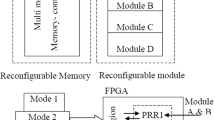Abstract
Digit serial–serial multipliers are one approach to power-optimize multiplication where operands are fed one digit at a time. This significantly reduces the required chip area and hence reducing power. In this paper, a power-efficient reconfigurable digit serial–serial multiplier is proposed. Power efficiency is achieved using two techniques: reconfiguration and clock gating. Reconfiguration allows the proposed multiplier to perform multiplication of sub-width operands without extending to full width, that is, a multiplier composed of m sub-multipliers each of width n is capable of handling \(mn \times mn\), \(1/2mn \times 1/2mn\), \(1/4mn \times 1/4mn,\ldots , n \times n\) multiplications. It also enables the multiplier to perform multiple multiplications concurrently rather than sequentially, that is, the multiplier is capable of handling \(1 \times ( mn \times mn)\), \(2\times (1/2mn \times 1/2), 4\times (1/4mn \times 1/4mn), \ldots , m\times (n\times n)\) multiplications concurrently. Mathematical operations such as matrix product benefit most from concurrent multiplications. Clock gating is used to reduce power by disabling unused blocks and enabling utilized blocks only when their relevant inputs arrive. Compared with non-reconfigurable no-clock-gating design, simulation results show that the proposed multiplier reduces the power requirement. For \(m=2\), \(n=32\), and digit width \(d=4\) power is reduced by 38 % for \(32\times 32\) mode and by 49 % for \(2 \times (32 \times 32)\) mode. Compared with standard parallel multiplier, simulation results also show that the proposed multiplier reduces energy requirement. For \(m=2, n=32\), and digit width \(d=32\), energy is reduced by 46 % for \(32 \times 32\) mode and by 60 % for \(2 \times (32 \times 32)\) mode.










Similar content being viewed by others
References
Aggoun A, Farwan AF, Ibrahim MK, Ashur A (2004) Radix-2n serial-serial multipliers. In: IEE proceedings—circuits, devices and systems, vol 151(6), pp 503–509, 15 December 2004
Wu CW, Cappello PR (1989) Block multipliers unify bit-level cellular multiplications. Int J Comput Aided VLSI Des 1:113–125
Nibouche C, Nibouche M (2002) On designing digit multipliers. In: 9th International conference on electronics, circuits and systems, vol 3, pp 951–954
Krithivasan S, Schulte MJ (2003) Multiplier architectures for media processing. Proc IEEE Asilomar Conf Signals Syst Comput 2:2193–2197
Krithivasan S, Schulte MJ, Glossner J (2004) A subword parallel multiplication and sum-of-squares unit. In: Proceedings of the IEEE CS annual symposium on very large scale integration (VLSI) systems, pp 273–274
Tsao Y-L, Chen W-H, Tan M-H, Lin M-C, Jou S-J (2003) Low-power embedded DSP core for communication systems. EURASIP J Appl Signal Process 1355–1370
Tatas K, Koutroumpezis G, Soudris D, Thanailakis A (2007) Architecture design of a coarse-grain reconfigurable multiply-accumulate unit for data-intensive applications. Integr VLSI J 40:74–93
Wey CL, Li JF (2004) Design of reconfigurable array multipliers and multiplier-accumulators. In: Proceedings of the IEEE Asia–Pacific conference on circuits and systems, pp 37–40
Tan D, Danysh A, Liebelt M (2003) Multiple-precision fixed-point vector multiply-accumulator using shared segmentation. In: Proceedings of the IEEE symposium on computer arithmetic, pp 12–19
Jin-Hao T, Lan-Da V (2009) Power-efficient pipelined reconfigurable fixed-width Baugh–Wooley multipliers. In: IEEE transactions on computers, vol 58(10)
Huang Y-H, Ma H-P, Liou M-L, Chiueh T-D (2004) A 1.1 G MAC/s subword-parallel digital signal processor for wireless communication applications. IEEE J Solid State Circuits 39(1):169–183
Haynes SD, Cheung PYK (1998) Configurable multiplier blocks for embedding in FPGAs. Electron Lett 34(7):638–639
Lin R (2001) Reconfigurable parallel inner product processor architecture. In: IEEE transaction on very large scale integration (VLSI) systems, vol 9(2), pp 261–272
Pfänder OA, Pfleiderer HJ, Lachowicz SW (2006)Configurable multiplier modules for an adaptive computing system.Adv Radio Sci 4:231-236. doi:10.5194/ars-4-231-2006
Di J, Yuan JS (2003) Run-time reconfigurable power-aware pipelined signed array multiplier design. In: Proceedings of the IEEE international symposium on signals, circuits, and systems, vol 2, pp 405–406
Sjalander M, Drazdziulis M, Larsson-Edefors P, Eriksson H (2005) A low-leakage twin-precision multiplier using reconfigurable power gating. In: Proceedings of the IEEE international symposium on circuits, and systems, vol 2, pp 1654–1657
Kuang S-R, Wang J-P (2007) Design of power-efficient pipelined truncated multipliers with various output precision. IET Comput Digit Tech 1:129–136
Thapliyal H, Arabnia HR, Srinivas MB (2009) Efficient reversible logic design of BCD subtractors. Trans Comput Sci J 99–121 (Springer-Verlag, vol III, LNCS 5300, ISSN 1866-4733, transactions, ISSN 0302-9743, LNCS)
Thapliyal H, Jayashree HV, Nagamani AN, Arabnia HR (2013) Progress in reversible processor design: a novel methodology for reversible carry look-ahead adder. In: Gavrilova ML, Tan CJK (eds) Transactions in computational science (Springer), vol XVII, LNCS 7420, Springer, Berlin, pp 73–97(ISBN # 978-3-642-35839-5)
Thapliyal H, Arabnia HR, Srinivas MB (2006) Reduced area low power high throughput BCD adders for IEEE 754r format. In: Proceedings of the 11th international CSI computer conference (sponsors: Institute for Studies in Theoretical Physics and Mathematics (IPM) and CSI, etc), vol 2, pp 59–64, Tehran, 24–26 January 2006
Himanshu T, Srinivas MB, Arabnia HR (2005) Reversible logic synthesis of half, full and parallel subtractors. In: Proceedings of the 2005 international conference on embedded systems and applications, ESA’05, Las Vegas, pp 165–172
Himanshu T, Srinivas M B, Arabnia HR (2005) A need of quantum computing: reversible logic synthesis of parallel binary adder–subtractor. In: Proceedings of the 2005 international conference on embedded systems and applications, ESA’05, Las Vegas, pp 60–66
Elsayed E, El-Boghdadi HM (2014) Area-efficient digit serial-serial two’s complement multiplier. J Circuits Syst Comput 23(7)
Fridman J (2000) Sub-word parallelism in digital signal processing. IEEE Signal Process Mag 17(2):27–35
Nguyen HV, John LK (1999) Exploiting SIMD parallelism in DSP and multimedia algorithms using the AltiVec technology. In: Proceedings of the ACM international conference on supercomputing, pp 11–20
Baumstark LB, Wills LM (2005) Retargeting sequential image-processing programs for data parallel execution. IEEE Trans Softw Eng 31(2):116–136
Limousin C et al (2001) Improving 3D geometry transformations on a simultaneous multithreaded SIMD processor. In: Proceedings of the 15th international conference on supercomputing. ACM, New York
Author information
Authors and Affiliations
Corresponding author
Rights and permissions
About this article
Cite this article
Elsayed, E., El-Boghdadi, H.M. A novel power-efficient multi-operand digit-multiplier using reconfiguration and clock gating. J Supercomput 71, 2539–2564 (2015). https://doi.org/10.1007/s11227-015-1403-2
Published:
Issue Date:
DOI: https://doi.org/10.1007/s11227-015-1403-2




